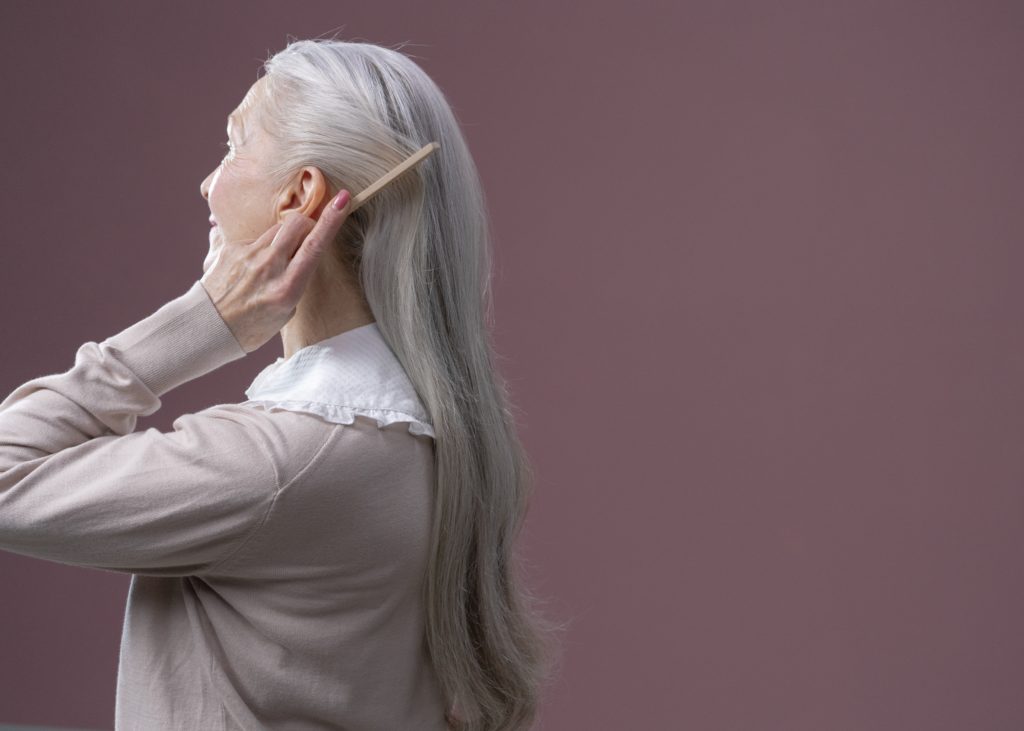
Nothing conveys youthful health and vigor like a full head of bouncy, soft, and shiny hair. But hair treatments and the aging process can take a toll on hair’s texture and appearance. Read on to learn how to keep your hair looking full and healthy.
Adopt a Hair-Healthy Diet
The look and feel of your hair reflects your nutritional status and overall state of health. To produce healthy, luxurious hair requires a variety of essential nutrients, including adequate protein and an array of vitamins and minerals. These include:
- Biotin – a member of the vitamin B-complex family, promotes production of the hair protein keratin.
- Iron – ensures proper reproduction of rapidly reproducing hair follicle cells.
- Selenium – a powerful antioxidant that protects hair follicles and also ensures proper pigmentation of the skin and hair.
- Vitamin A – supports skin and scalp health and protects hair follicles via antioxidant activity.
- Zinc – ensures healthy follicle cell division and protein production.
- Vitamin C – helps maintain healthy hair follicles; deficiency leads to decreased keratin bonding in hair and altered hair texture.
- Vitamin D – acts as a hormone in the skin, where it regulates the growth and maturation of hair follicles; deficiency has been associated with some forms of alopecia.
- Vitamin E – protects hair follicles via antioxidant activity.
Eating a diet high in processed foods depletes nutrient status, while certain health conditions, such irritable bowel syndrome, and some prescription drugs can impair nutrient absorption. And with age production of digestive enzymes declines, which also impairs absorption. For these reasons, it’s estimated that 50% of older Americans don’t get the RDA of all essential nutrients.
Stress and Hair Loss
Stress raises levels of cortisol, a powerful hormone that, in excess, can lead to hair loss by suppressing formation of hyaluronic acid and other compounds that hair follicles need to function properly. Stress also causes hair follicles to go into a resting state, contributes to endocrine imbalances that can cause hair follicles to shrink in size and produce thinner hair strands, and contributes to immune dysregulation and the development of alopecia areata. Additionally, stress depletes nutrient status by promoting intestinal inflammation and increasing oxidation, which is known to be a significant contributing factor to some forms of alopecia. Managing stress levels by maintaining healthy interpersonal boundaries, getting plenty of exercise, and eating a healthy diet can help provide a foundation for healthy hair.
Moisturize From the Inside with Hyaluronic Acid
The body’s natural moisturizer, hyaluronic acid is a slippery, water-attracting substance that helps hair follicles stay hydrated. This makes hair appear smoother and prevents frizz. With the aging process hyaluronic acid levels decrease, leading to dry, thin, wiry looking hair. Supplementation with hyaluronic acid can help restore your hair’s moisture levels and improve its appearance.
Sleep on a Silk Pillowcase
It might sound like an indulgence, but sleeping on a silk pillowcase could be money well-spent for the health of your hair. Silk’s smooth cylindrically shaped fibers are similar in structure to human hair, giving it similar properties.
Being slightly slippery, silk reduces friction between your hair and pillowcase, preventing the frizzy “bedhead” effect and keeping long hair tangle-free. Its smooth texture makes silk less moisture-absorbing than cotton–which can leave hair dry, brittle, and prone to breakage and dandruff–and also helps reduce damage from heat or chemical hair treatments. Similarly, silk repels oils so it won’t strip your hair of its natural oils or oil treatments. And in warm weather, or if you tend to “sleep hot”, silk wicks away excess moisture. Silk is also resistant to static electricity, which can make hair less manageable. Additionally, if you have a sensitive scalp or an autoimmune condition that affects your skin, silk is a great hypoallergenic option with less tendency to irritate.
Use Less-Damaging Dyes
Permanent hair dying, particularly involving bleach, strips away the hair’s outer protective layer of protein, leaving hair weaker, thinner, and drier. And the longer bleach is left in, the more damage the hair sustains.
Temporary, or semi-permanent dyes are a less damaging option, but even these can cause hair damage. For example, henna can damage the hair cuticle, causing it to become brittle and coarse. And, as with bleach, longer application time equates to greater damage.
Here are a few things you can do to offset the harsh effects of hair dye:
- Choose dyes with added conditioners. These contain ingredients such as hydrolyzed silk and milk proteins.
- Use heat styling techniques sparingly.
- Choose colors that require shorter processing time.
- Use moisturizing shampoos and conditioners.
- Use hair care products designed for color-treated hair.
With proper care, you can have healthy, beautiful hair at any age. If you notice unexplained hair loss or changes to your hair, consult with your healthcare provider to rule out a possible medical cause.